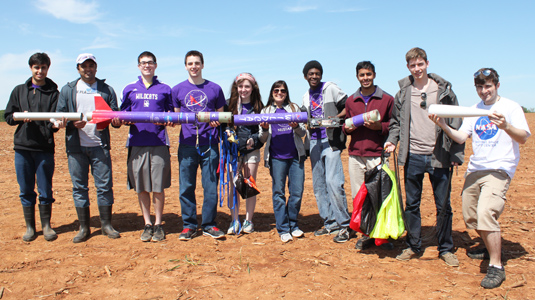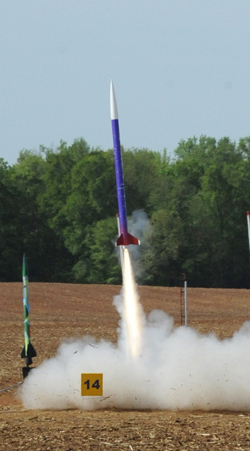Northwestern Student Group Breaks Record with Rocket Launch
NUSTARS comes just feet away from target in NASA University Student Launch Initiative

Northwestern students go the extra mile. If they’re NUSTARS, they go a mile and six feet.
The Northwestern University Space Technology and Rocketry Society (NUSTARS) broke a record last week when they launched a homemade rocket in NASA’s University Student Launch Initiative outside Huntsville, Alabama.
Forty teams from around the country competed in the April 22 competition, in which students were challenged with designing a rocket that would reach 5,280 feet, or one mile, in altitude without going over. Northwestern’s nine-foot rocket reached 5,286 feet.
In scoring, the team was docked several points for passing the one-mile mark, so they missed out on the first-place Altitude Award. (That honor went to Alabama A&M, whose rocket was 11 feet shy of one mile.)
But Northwestern did take second place — and they snagged a record as the team to come closest to the one-mile altitude target in the history of the competition. (The previous closest flight to 5,280 feet was 5,270.)
“It was especially exciting because it was our first time competing,” said Samantha Stahl, a sophomore electrical engineering major at Northwestern’s McCormick School of Engineering and NUSTARS member.

NUSTARS spent eight months perfecting their rocket. They started by building a three-foot prototype in McCormick’s Ford Motor Company Engineering Design Center to test its aerodynamics and stability.
During winter quarter, the team began doing test launches of a full-size rocket in rural Illinois and Wisconsin. The students used a prefab motor to determine how high their fiberglass rocket would travel, then adjusted the rocket’s mass, or “ballast,” and propellant system to try to reach the optimal height.
Other factors, such as humidity and atmospheric pressure, can also affect a rocket’s performance, said Dan Abramov, a senior studying physics and astronomy in Northwestern’s Weinberg College of Arts and Sciences and one of NUSTARS’ founders.
“All of those factors worked in our favor in Huntsville,” Abramov said. “It’s like they say, luck is when preparation meets opportunity. And we did it.”
NUSTAR’s final rocket carried a GPS unit, GoPro camera, and humidity, pressure, and temperature sensors. The data were beamed wirelessly to the ground and also collected in the rocket’s electronic system, also designed by Northwestern students.
During the five-day competition, the students also had the opportunity to tour NASA’s Marshall Space Flight Center, explore aerospace manufacturing labs, and see test flights of propulsion vehicles.